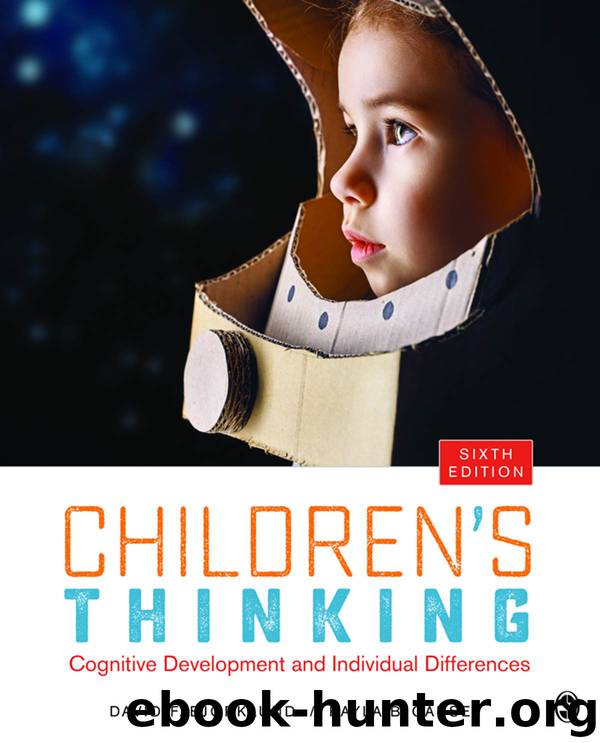Children's Thinking: Cognitive Development and Individual Differences by David F. Bjorklund & Kayla B. Causey

Author:David F. Bjorklund & Kayla B. Causey [Bjorklund, David F.]
Language: eng
Format: azw3
Publisher: SAGE Publications
Published: 2017-01-04T05:00:00+00:00
Some Theoretical Perspectives of Language Development
The question central to language acquisition has been the acquisition of syntax. How is it that children make sense of the jumble of sounds that surrounds them to eventually discover the underlying rules of language? Although each of the world’s 7,000-plus languages might have some unique features to them, they also all have some things in common with one another. That is, they all possess, at some “deep level,” some common aspects of syntax (see MacWhinney, 2015; Pinker, 1994). In this section, we do not intend to cover the intricacies of theories of syntax development in great detail but merely to describe some of the major points of the dominant perspectives so that the reader can get a general idea of how children approach the seemingly complicated task of learning to talk (see Hoff, 2014; MacWhinney, 2015; Tomasello, 2006).
In very general terms, three major types of theories have been postulated to account for language acquisition: (1) behavioral theories, (2) nativist theories, and (3) social-interactionist theories. Behavioral theories were popular in the early and middle part of the last century and proposed, basically, that children learn language like they learn any other complex behavior, through the principles of classical and operant conditioning (Skinner, 1957). Behaviorists emphasized the role of parents as models of, and reinforcers for, language. The behaviorists actually paid relatively little attention to children, who for generations had been producing perfectly understandable original sentences and phrases they could not have possibly learned through conditioning and imitation, such as “all-gone, sticky” to announce that their hands have been washed.
Many claims of the behaviorists have not stood the test of time. For example, although words can be learned through conditioning principles in the laboratory, little evidence suggests that parents use such structured techniques at home; yet almost all children are fluent in their native language before they reach school age. Other research has shown that parents seldom comment to children about the grammatical correctness of their spoken messages, only the meaningfulness of them (R. Brown & Hanlon, 1970), and although new words are obviously learned by imitation, new grammatical forms (such as plurals or the past tense) are typically not imitated until children are able to produce them spontaneously (L. Bloom, Hood, & Lightbown, 1974). In addition, although 2- and 3-year-old children hear between 5,000 and 7,000 utterances each day, more than 20% of those utterances are incomplete sentence fragments, and only about 15% are in the subject-verb-object form that is standard for English (Cameron-Faulkner, Lieven, & Tomasello, 2003). All this makes it very unlikely that a behavioral theory of language development is adequate. Thus, one way in which children apparently do not learn the syntax of their mother tongue is through the conventional rules of classical and operant conditioning.
More recent research, however, has discovered that infants seemingly use a domain-general mechanism of statistical learning to discern what is a word and what is not, consistent with some claims of the behavioral position (Aslin, Saffran, & Newport, 1998; Saffran, Aslin, & Newport, 1996).
Download
This site does not store any files on its server. We only index and link to content provided by other sites. Please contact the content providers to delete copyright contents if any and email us, we'll remove relevant links or contents immediately.
The Art of Thinking Clearly by Rolf Dobelli(10149)
Mindhunter: Inside the FBI's Elite Serial Crime Unit by John E. Douglas & Mark Olshaker(9112)
Change Your Questions, Change Your Life by Marilee Adams(7574)
Nudge - Improving Decisions about Health, Wealth, and Happiness by Thaler Sunstein(7469)
Mastermind: How to Think Like Sherlock Holmes by Maria Konnikova(7171)
The Power of Now: A Guide to Spiritual Enlightenment by Eckhart Tolle(5550)
Men In Love by Nancy Friday(5120)
Altered Sensations by David Pantalony(5013)
Factfulness: Ten Reasons We're Wrong About the World – and Why Things Are Better Than You Think by Hans Rosling(4635)
The Confidence Code by Katty Kay(4166)
Thinking in Bets by Annie Duke(4127)
Man and His Symbols by Carl Gustav Jung(4016)
The Worm at the Core by Sheldon Solomon(3401)
Why Buddhism is True by Robert Wright(3378)
Liar's Poker by Michael Lewis(3330)
Three Women by Lisa Taddeo(3327)
The Inner Life of Animals by Peter Wohlleben(3204)
Descartes' Error by Antonio Damasio(3194)
The Power of Mindful Learning by Ellen J. Langer(3137)
